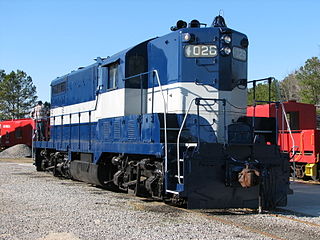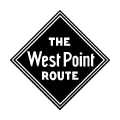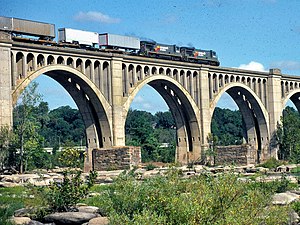
CSX Transportation, known colloquially as simply CSX, is a Class I freight railroad company operating in the Eastern United States and the Canadian provinces of Ontario and Quebec. Operating about 21,000 route miles (34,000 km) of track, it is the leading subsidiary of CSX Corporation, a Fortune 500 company headquartered in Jacksonville, Florida.
Chessie System, Inc. was a holding company that owned the Chesapeake and Ohio Railway (C&O), the Baltimore and Ohio Railroad (B&O), the Western Maryland Railway (WM), and Baltimore and Ohio Chicago Terminal Railroad (B&OCT). Trains operated under the Chessie name from 1973 to 1987.

The Seaboard Coast Line Railroad was a Class I railroad company operating in the Southeastern United States beginning in 1967. Its passenger operations were taken over by Amtrak in 1971. Eventually, the railroad was merged with its affiliate lines to create the Seaboard System in 1983.

The Louisville and Nashville Railroad, commonly called the L&N, was a Class I railroad that operated freight and passenger services in the southeast United States.
Seaboard Coast Line Industries, Inc., incorporated in Delaware on May 9, 1969, was a railroad holding company that owned the Seaboard Coast Line Railroad, its subsidiary Louisville and Nashville Railroad, and several smaller carriers. Its railroad subsidiaries were collectively known as the Family Lines System. Its headquarters were in Jacksonville, Florida, in the United States. Through 1979, the Family Lines network totaled 16,326 miles (26,274 km) in 13 states.

The Georgia Railroad and Banking Company also seen as "GARR", was a historic railroad and banking company that operated in the U.S. state of Georgia. In 1967 it reported 833 million revenue-ton-miles of freight and 3 million passenger-miles; at the end of the year it operated 331 miles (533 km) of road and 510 miles (820 km) of track.

The Atlanta and West Point Rail Road was a railroad in the U.S. state of Georgia, forming the east portion of the Atlanta-Selma West Point Route. The company was chartered in 1847 as the Atlanta and LaGrange Rail Road and renamed in 1857; construction of the 5 ft gauge line was begun in 1849-50 and completed in May 1854. A large minority interest owned by the Georgia Railroad and Banking Company eventually passed under the control of the Atlantic Coast Line Railroad (ACL), which later acquired a majority of the stock.
The Western Railway of Alabama (WRA) also seen as "WofA" was created as the Western Railroad of Alabama by the owners of the Montgomery & West Point Railroad (M&WP) in 1860. It was built to further the M&WP's development West from Montgomery, Alabama to Selma, Alabama. When the line was constructed in 1870, the M&WP was merged into the WRA, creating a line from Selma to West Point, Georgia. It served Auburn, Alabama and connected in Opelika, Alabama to the Central of Georgia line from Columbus, Georgia to Birmingham, Alabama. Although it was partially owned by the Central of Georgia around the turn from the nineteenth to the twentieth century, it did not end up being owned by Norfolk Southern when that company came into existence due to the merger of the CofG's parent, the Southern Railway, and the Norfolk & Western Railway.

The EMD GP16 are a series of rebuilt diesel-electric locomotives, a result of a remanufacturing program initiated by the Seaboard Coast Line Railroad (SCL) in an effort to spare the cost of purchasing new motive power in the late 1970s. This involved the rebuilding of their aging fleet of EMD GP7, GP9 and GP18 road switchers. 155 locomotives were rebuilt by the SCL.

The Wiregrass Central Railroad is a shortline railroad operating 19.5 miles (31.4 km) of track from a CSX Transportation connection at Waterford, near Newton, to Enterprise, Alabama via the south side of Fort Novosel. The company was initially a subsidiary of Gulf and Ohio Railways and began operations in 1987 following the purchase of the Enterprise Subdivision branch line of CSX Transportation.
The CL&W Subdivision is a railroad line owned and operated by CSX Transportation in the U.S. state of Ohio. The line runs from a junction with the New Castle Subdivision at Sterling northwest to Lorain along a former Baltimore and Ohio Rail Road line. It junctions with the Cleveland Subdivision at Lester and the Greenwich Subdivision at Grafton.
The Haysi Railroad Company was a terminal/switching railroad that owned and operated seven miles of track from Haysi, Virginia, to Vicey, Virginia. The railroad was known most for its unusual motive power.
The Abbeville Southern Railway was incorporated in Alabama in September 1892 for the purpose of building a railroad line from Grimes, Alabama northeast to Abbeville, Alabama. The route was completed in December 1893, totaling 26.9 miles (43.3 km), and was operated by the Alabama Midland Railway.

The Palmetto Subdivision is a CSX Transportation rail line in the Tampa Bay region of Florida. It runs from just south of Tampa south to Bradenton.
CSX Transportation's Atlanta Terminal Subdivision comprises the company's railroad lines and infrastructure operating in and around Atlanta, Georgia. The Atlanta Terminal Subdivision consists of five lines and a number of yards. Most of the lines in the Atlanta Terminal Subdivision date back to the 1800s.
The Lineville Subdivision is a railroad line currently operated by CSX Transportation in Georgia and Alabama. It runs from Parkwood southeast though Lineville, Alabama to Manchester, Georgia, a distance of 179.4 miles (288.7 km). It connects with CSX's Manchester Subdivision and Fitzgerald Subdivision in Manchester.
The Manchester Subdivision is a railroad line currently operated by CSX Transportation in Central Georgia. Its northern terminus is in Peachtree City, where it continues south from the Atlanta Terminal Subdivision. From Peachtree City, it runs for 38.8 miles (62.4 km) south to Manchester, Georgia, where it connects with CSX's Lineville Subdivision and Fitzgerald Subdivision. It is a major north-south route for CSX in Georgia.
The Portsmouth Subdivision is a railroad line owned by CSX Transportation in Virginia and North Carolina. The line connects CSX's network with the port city of Portsmouth, Virginia. The Portsmouth Subdivision was historically operated by the Seaboard Air Line Railroad, a CSX predecessor.
The Kentucky Steam Heritage Corporation (KSHCO) is a nonprofit organization based on the border between Irvine and Ravenna, Kentucky. The organization mainly focuses on the restoration of Chesapeake and Ohio K-4 2-8-4 steam locomotive No. 2716 along with other vintage railroad equipment. The organization has plans of turning the surrounding area into its own tourist attraction called the Kentucky Rail Heritage Center through a partnership with the R.J. Corman Railroad Group and CSX Transportation.










